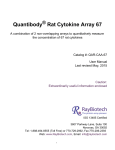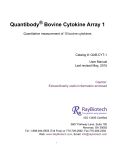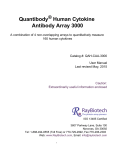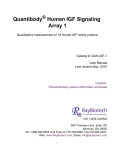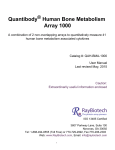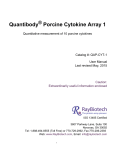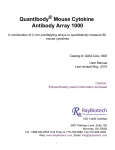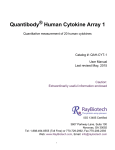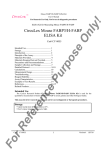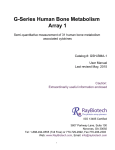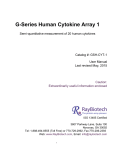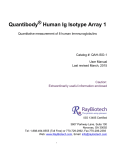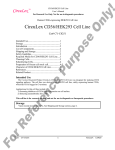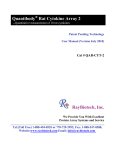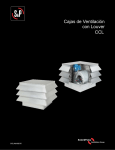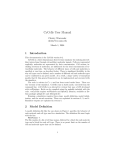Download Manual - RayBiotech, Inc.
Transcript
Quantibody® Human Dry Eye Disease Array 1 Quantitative measurement of 40 human Dry Eye Disease associated cytokines Catalog #: QAH-DED-1 User Manual Last revised May, 2015 Caution: Extraordinarily useful information enclosed ISO 13485 Certified 3607 Parkway Lane, Suite 100 Norcross, GA 30092 Tel: 1-888-494-8555 (Toll Free) or 770-729-2992, Fax:770-206-2393 Web: www.RayBiotech.com, Email: [email protected] 1 Table of Contents Section Page # I. Overview 3 II. Introduction 3 III. How It Works 5 IV. Materials Provided 6 V. Storage 6 VI. Additional Materials Required 6 VII. General Considerations A. Sample Preparation B. Handling Glass Slides C. Incubation 7 7 7 7 VIII. Protocol A. Completely Air Dry The Glass Slide B. Prepare Cytokine Standard Dilutions C. Blocking & Incubation D. Incubation with Biotinylated Antibody Cocktail & Wash E. Incubation with Cy3 Equivalent Dye-Streptavidin & Wash F. Fluorescence Detection G. Data Analysis 8 8 8 9 10 10 11 12 IX. Array Map & Standard Curves 13 X. Standard Concentrations 14 XI. Spiking & Recovery 15 XII. Q-Analyzer: Data Analysis Software 16 XIII. Troubleshooting Guide 17 XIV. Select Publications 18 XV. Experiment Record Form 19 XVI. How To Choose A Quantibody® 20 Please read the entire manual carefully before starting your experiment 2 I. Overview Cytokines Detected (40) Format Detection Method EGF, EGFR, Eotaxin-1 (CCL11), GCSF, GRO alpha/beta/gamma, HB-EGF, ICAM-1 (CD54), IFN-gamma, IL-1 alpha (IL-1 F1), IL-1 beta (IL-1 F2), IL-1 ra (IL-1 F3), IL10, IL-11, IL-12 p40, IL-12 p70, IL-13, IL-15, IL-16, IL-17A, IL2, IL-4, IL-5, IL-6, IL-6 R, IL-7, IL-8 (CXCL8), IP-10 (CXCL10), Lipocalin-2 (NGAL), MCP-1 (CCL2), MIG (CXCL9), MIP-1 alpha (CCL3), MIP-1 beta (CCL4), MIP-1 delta (CCL15), MMP-9, RANTES (CCL5), TGF beta 1, TIMP1, TIMP-2, TNF alpha, VEGF-A See Section IX for Array Map One standard glass slide is spotted with 16 wells of identical cytokine antibody arrays. Each antibody is arrayed in quadruplicate. Fluorescence. Go to www.RayBiotech.com/Scanners for a list of compatible laser scanners. Sample Volume 50 - 100 µl per array Reproducibility CV <20% Assay Duration 6 hours II. Introduction Dry eye disease (DED) is a multifactorial chronic disorder of the ocular surface that affects up to 100 million people worldwide. As is typical of multifactorial diseases, symptoms of DED are often nonspecific ranging from simple ocular irritation to functional blindness. DED can be broadly classified as either aqueous-deficient dry eye (due to failure of tear secretion) or evaporative dry eye (due to excessive tear evaporation rate). Because evaporative and aqueous-deficient DED have different pathogenetic mechanisms, different biomarkers are necessary to identify the specific disease type. Although DED can be diagnosed through functional tests (such as evaporimetry, Schirmer test, optical scattering, TBUT, interferometry, and Blink Rate), they all have limitations with respect to their selectivity and specificity. Moreover, they give little indication of patients' 3 disease severity and tend to reflect only late changes induced by the disease. For these reasons, the identification of dry eye biomarkers could be potentially useful in clinical practice for diagnosis, prognosis, and monitoring the effectiveness of treatment of DED patients. The tear hyperosmolarity triggers an inflammatory cytokines cascade. Many inflammatory cytokines including IL-1, IL-4, IL-5, IL-6, IL-8, IL-10, IL-12, IL-13, IL-17, TNF-alpha, and IFNgamma, have been identified in DED biomarker research. Other potential tear biomarkers in DED include EGF, VEGF, MMP-9, S100A8, S100A9, lactoferrin, lipocalin, lipophilin, cystatin, and proline-rich protein.The traditional method for cytokine detection and quantification is through the use of an enzyme-linked immunosorbent assay (ELISA). In this method, target protein is immobilized to a solid support. The immobilized protein is then complexed with an antibody that is linked to an enzyme. Detection of the enzyme complex can then be visualized through the use of a substrate that produces a detectable signal. While this traditional method works well for a single protein, the overall procedure is time consuming and requires a relatively high volume of sample. Thus, conservation of precious small sample quantities becomes a challenging task. Innovations in microarray technology over the last decade have addressed this problem. A long-standing leader in the field, Raybiotech, has pioneered the development of cytokine antibody arrays, which have now been widely applied in the research community with hundreds of peer reviewed publications, including top-tier journals such as Cell and Nature. The Quantibody® array, our multiplexed sandwich ELISA-based quantitative array platform, enables researchers to accurately determine the concentration of multiple cytokines simultaneously. It combines the advantages of the high detection sensitivity & specificity of ELISA and the high throughput of arrays. Like a traditional sandwich-based ELISA, it uses a pair of cytokine specific antibodies for detection. A capture antibody is first bound to the glass surface. After incubation with the sample, the target cytokine is trapped on the solid surface. A second biotin-labeled detection antibody is then added, which can recognize a different epitope of the target cytokine. The cytokine-antibody-biotin complex can then be visualized through the addition of the streptavidin-conjugated Cy3 equivalent dye, using a laser scanner. Unlike the traditional ELISA, Quantibody products use an array format. By arraying multiple cytokine specific capture antibodies onto a glass support, quantitative, multiplex detection of cytokines in one experiment is made possible. In detail, one standard glass slide is divided into 16 wells of identical cytokine antibody arrays. Each antibody, together with the positive controls is arrayed in quadruplicate. The slide comes with a 16-well removable gasket which allows for the process of 16 samples on one slide. Four slides can be nested into a tray, which matches a standard microplate footprint and allows for automated robotic high throughput process of 64 arrays simultaneously. For cytokine quantification, the array specific cytokine standards, whose concentration has been predetermined, are provided to generate a standard curve for each cytokine. In a real experiment, standard cytokines and samples will be assayed in each array simultaneously through a sandwich ELISA procedure. By comparing signals from unknown samples to the standard curve, the cytokine concentration in the samples will be determined. 4 Quantibody® array kits have been confirmed to have similar detection sensitivity as traditional ELISA. Our current high density Quantibody kits allow scientists to quantitatively determine the concentration of 660 human, 200 mouse, and 67 rat cytokines in a single experiment. This is not only one of the most efficient products on the market for cytokine quantification, but makes it more affordable for quantification of large number of proteins. Simultaneous detection of multiple cytokines undoubtedly provides a powerful tool for drug and biomarker discovery. 5 III. How It Works 6 IV. Materials Provided Catalog # Component Name 1 Slide Box 2 Slide Box* 1 2 1 QAH-DED-1S Human Dry Eye Disease Array 1 Glass Slide 2 QA-SDB Quantibody® Sample Diluent 3 AA-WB1-30ML 20X Wash Buffer I 4 AA-WB2-30ML 20X Wash Buffer II 30 ml 5 QAH-DED-1-STD Human Dry Eye Disease Array 1 Lyophilized Standard Mix** 1 Vial 6 QAH-DED-1B Human Dry Eye Disease Array 1 Biotinylated Antibody Cocktail 7 QA-CY3E Cy3 equivalent dye-conjugated Streptavidin 8 QA-SWD Slide Washer/Dryer 1 x 30 ml Tube 9 QA-ADH Adhesive Film 1 15 ml 2 x 30 ml 3 x 30 ml 1-25 µl 2 x 1-25 µl 5 µl 2 x 5 µl 2 * 4 slide kits are comprised of 2 separate 2 slide kits. ** See Section X for detailed cytokine concentrations after reconstitution. V. Storage Upon receipt, all components should be stored at -20°C. The kit will retain activity for up to 6 months. Once thawed, the glass slide, standard mix, antibody cocktail and dye-conjugated Streptavidin should be kept at -20°C. All other components may be stored at 4°C. The entire kit should be used within 6 months of purchase. VI. Additional Materials Required Benchtop rocker or orbital rocker Laser scanner for fluorescence detection Aluminum foil Distilled water 1.5 ml Polypropylene microcentrifuge tubes 7 VII. General Considerations A. Preparation of Samples Use serum-free conditioned media if possible. If serum-containing conditioned media is required, it is highly recommended that complete medium be used as a control since many types of sera contains cytokines. We recommend the following parameters for your samples: 50 to 100 µl of original or diluted serum, plasma, cell culture media, or other body fluid, or 50500 µg/ml of protein for cell and tissue lysates. If you experience high background or if the fluorescent signal intensities exceed the detection range, further dilution of your sample is recommended. B. Handling Glass Slides Do not touch the surface of the slides, as the microarray slides are very sensitive. Hold the slides by the edges only. Handle all buffers and slides with powder free gloves. Handle glass slide/s in clean environment. The Quantibody slides do not have bar codes. To help distinguish one slide from another, transcribe the slide serial number from the slide bag to the back of the slide with a fine point permanent marker. Please write the number on the very bottom edge of the slide, taking care to avoid writing on the array well areas. C. Incubation Completely cover array area with sample or buffer during incubation. Avoid foaming during incubation steps. Perform all incubation and wash steps under gentle rocking or rotation. Cover the incubation chamber with adhesive film during incubation, particularly when incubation is more than 2 hours or <70 µl of sample or reagent is used. Several incubation steps such as step 6 (blocking), step 7 (sample incubation), step 10 (detection antibody incubation), or step 13 (Cy3 equivalent dyestreptavidin incubation) may be done overnight at 4°C. Please make sure to cover the incubation chamber tightly to prevent evaporation. 8 VIII. Protocol A. Completely Air Dry The Glass Slide 1. Take out the glass slide from the box, and let it equilibrate to room temperature inside the sealed plastic bag for 20-30 minutes. Remove slide from the plastic bag, peel off the cover film, and let it air dry for another 1-2 hours. Incomplete drying of slides before use may cause the formation of "comet tails," thin directional smearing of antibody spots. B. Prepare Cytokine Standard Dilutions There is only one vial of standard provided in the two-slide kit, which is enough for making two standard curves. Reconstitute the lyophilized standard within one hour of usage. If you must use the standard for two different days, store only the Std1 dilution at -80°C. 2. Reconstitute the Cytokine Standard Mix (lyophilized) by adding 500 µl Sample Diluent to the tube. For best recovery, always quick-spin vial prior to opening. Dissolve the powder thoroughly by a gentle mix. Labeled the tube as Std1. 3. Label 6 clean microcentrifuge tubes as Std2 to Std7. Add 200 µl Sample Diluent to each of the tubes. 9 4. Pipette 100 µl Std1 into tube Std2 and mix gently. Perform 5 more serial dilutions by adding 100 µl Std2 to tube Std3 and so on. 5. Add 100 µl Sample Diluent to another tube labeled as CNTRL. Do not add standard cytokines or samples to the CNTRL tube, which will be used as negative control. For best results, include a set of standards in each slide. Since the starting concentration of each cytokine is different, the serial concentrations from Std1 to Std7 for each cytokine are varied which can be found in Section X. C. Blocking & Incubation 6. Add 100 µl Sample Diluent into each well and incubate at room temperature for 30 minutes to block slides. 7. Decant buffer from each well. Add 100 µl standard cytokines or samples to each well. Incubate arrays at room temperature for 1-2 hour. Longer incubation time is preferable for higher signals. This step may be done overnight at 4°C. We recommend using 50 to 100 µl of original or diluted serum, plasma, conditioned media, or other body fluid, or 50-500 µg/ml of protein for cell and tissue lysates. Cover the incubation chamber with adhesive film during incubation, especially if less than 70 ul of sample or reagent is used. 8. Wash: Decant the samples from each well, and wash 5 times (5 min each) with 150 µl of 1X Wash Buffer I at room temperature with gentle rocking. Completely remove wash buffer in each wash step. Dilute 20x Wash Buffer I with H2O. (Optional for Cell and Tissue Lysates) Put the glass slide with frame into a box with 1X Wash Buffer I (cover the whole glass slide and frame with Wash Buffer I), and wash at room temperature with gentle rocking for 20 min. 10 Decant the 1x Wash Buffer I from each well, wash 2 times (5 min each) with 150 µl of 1X Wash Buffer II at room temperature with gentle rocking. Completely remove wash buffer in each wash step. Dilute 20X Wash Buffer II with H2O. Incomplete removal of the wash buffer in each wash step may cause "dark spots," the background signals higher than the spots. D. Incubation with Biotinylated Antibody Cocktail & Wash 9. Reconstitute the detection antibody by adding 1.4 ml of Sample Diluent to the tube. Spin briefly. 10. Add 80 µl of the detection antibody cocktail to each well. Incubate at room temperature for 1-2 hour. Longer incubation time is preferable for higher signals and backgrounds 11. Decant the samples from each well, and wash 5 times (5 mins each) with 150 µl of 1X Wash Buffer I and then 2 times with 150 µl of 1x Wash Buffer II at room temperature with gentle rocking. Completely remove wash buffer in each wash step. E. Incubation with Cy3 Equivalent Dye-Streptavidin & Wash 12. After briefly spinning down, add 1.4 ml of Sample Diluent to Cy3 equivalent dye-conjugated streptavidin tube. Mix gently. 13. Add 80 µl of Cy3 equivalent dye-conjugated streptavidin to each well. Cover the device with aluminum foil to avoid exposure to light or incubate in dark room. Incubate at room temperature for 1 hour. 14. Decant the samples from each well, and wash 5 times (5 mins each) with 150 µl of 1X Wash Buffer I at room temperature with gentle rocking. Completely remove wash buffer in each wash step. 11 F. Fluorescence Detection 15. Disassemble the device by pushing clips outward from the slide side. Carefully remove the slide from the gasket. Be careful not to touch the surface of the array side. 16. Place the slide in the Slide Washer/Dryer (a 4-slide holder/centrifuge tube), add enough 1x Wash Buffer I (about 30 ml) to cover the whole slide, and then gently shake at room temperature for 15 minutes. Decant Wash Buffer I. Wash with 1x Wash Buffer II (about 30 ml) and gently shake at room temperature for 5 minutes. 17. Remove water droplets completely by gently applying suction with a pipette to remove water droplets. Do not touch the array, only the sides. You may also dry the glass slide by a compressed N 2 stream. 18. Imaging: The signals can be visualized through use of a laser scanner equipped with a Cy3 wavelength (green channel) such as Axon GenePix. Make sure that the signal from the well containing the highest standard concentration (Std1) receives the highest possible reading, yet remains unsaturated. In case the signal intensity for different cytokine varies greatly in the same array, we recommend using multiple scans, with a higher PMT for low signal cytokines, and a low PMT for high signal cytokines. 12 G. Data Analysis 19. Data extraction can be done using the GAL file that is specific for this array along with the microarray analysis software (GenePix, ScanArray Express, ArrayVision, MicroVigene, etc.). GAL files can be found here: www.RayBiotech.com/Gal-Files.html. Need help analyzing all that data? Copy and paste your data into the QAnalyzer Tool specific for this array, catalog number: QAH-DED-1-SW. More information can be found in Section XII. 13 IX. Array Map & Standard Curves 14 X. Standard Concentrations After reconstitution, the lyophilized cytokine standard mix contains the following concentrations for each antigen included. 15 XI. Spiking & Recovery The antibody pairs used in the kit have been tested to recognize their specific antigen. The spiking and recovery rates of each cytokine in 2x diluted serum (SR), plasma EDTA (PLE), plasma citrate (PLC), plasma heparin (PLH), and culture media (CM) are listed in the following tables. 16 XII. Quantibody® Q-Analyzer The Q-Analyzer is an array specific, Excel-based program. It is much more than a simple calculation macro; it performs sophisticated data analysis (see below for description). The Q-Analyzer Tool specific for this array is catalog number: QAH-DED-1-SW. Key features: Simplicity: Easy to operate and requires no professional training. With a simple copy and paste process, the cytokine concentration is determined. Outlier Marking & Removing: The software can automatically mark and remove the outlier spots for more accurate data analysis Normalization: The program allows for intra- and inter-slide normalization for large numbers of samples. Two Positive Controls: The program utilizes the two positive controls in each array for normalization. Two Analytical Algorithms: Users can choose either linear regression or log-log algorithms to meet their analytical needs. Two Data Outputs: standard curves and digital concentration. User Intervention: The program allows for user manual handling of outliers and other analytical data. Lower and Upper Limits Determination: The program automatically marks out the values below or above the detection range. Standard Deviation: The program outputs the standard deviations of the quadruplicate spots for data accuracy. Analytical Tips: Q-Analyzer analysis tips are included in the program. 17 XIII. Troubleshooting Guide Problem Weak Signal Uneven signal Poor standard curve High background Cause Recommendation Inadequate detection Increase laser power and PMT parameters Inadequate reagent volumes or improper dilution Check pipettes and ensure correct preparation Short incubation time Increase incubation time or change sample incubation step to overnight Too low protein concentration in sample Lessen dilution or do not dilute sample. Concentrate sample if necessary. Improper storage of kit Store kit as suggested temperature. Don't freeze/thaw the slide. Bubble formed during incubation Decrease amount of rocking during incubations. check for bubble formation and remove bubbles. Arrays are not completed covered by reagent Completely cover arrays with solution for all required steps. Reagent evaporation Cover the incubation chamber with adhesive film during incubation Cross-contamination from neighboring wells Avoid overflowing wash buffer and other solutions into neighboring wells. Comet tail formation Air dry the slide for at least 1 hour before usage Inadequate standard reconstitution or Improper dilution Reconstitute the lyophilized standard well at the room temperature before making serial dilutions. Check pipettes and ensure proper serial dilutions. Inadequate detection Increase laser power so the highest standard concentration for each cytokine receives the highest possible reading yet remains unsaturated. Use freeze-thawed cytokine standards Always use new cytokine standard vial for new set of experiment. Discard any leftover. Overexposure Lower the PMT or sigmal gain. Dark spots Completely remove wash buffer in each wash step. Insufficient wash Increase wash time and use more wash buffer Dust Work in clean environment Slide is allowed to dry out Don't dry out slides during experiment. 18 XIV. Select Quantibody® Publications 1. Zeng Q., et al. The functional behavior of a macrophage/fibroblast co-culture model derived from normal and diabetic mice with a marine gelatin-oxidized alginate hydrogel. Biomaterials. 2010 Aug;31(22):5772-81. doi: 10.1016/j.biomaterials.2010.04.022. Species: Mouse 2. Toh H, Wang W, Chia W, Kvistborg P, Sun Li,et al. Clinical Benefit of Allogeneic Melanoma Cell LysatePulsed Autologous Dendritic Cell Vaccine in MAGE-Positive Colorectal Cancer Patients.Clin Cancer Res. 2009;15(24):7726-7736 Species: Human Sample Type: Plasma 3. Du Y, Wei X, He Y, Wei G, Hampel H, et al. P2-380: Identification and characterization of human autoantibodies that may be used for the treatment of prion diseases. Alzheimer Dementia. 2008;4(4 Suppl):T484 (Abstract P2-380). Species: Human Sample Type: Plasma 4. Jonnalagadda D., et al. Platelet secretion is kinetically heterogeneous in an agonist-responsive manner. December 20, 2012; Blood: 120 (26). http://dx.doi.org/10.1182/blood-2012-07-445080 Species: Human Sample Type: Conditioned Media 5. Vargas-Inchaustegui D., Hogg A., Tulliano G., et al.CXCL10 Production by Human Monocytes in Response to Leishmania braziliensis Infection. Infect. Immun. January 2010 vol. 78 no. 1 301-308 Species: Human Sample Type: Serum 6. Zhai Y, Zhong Z, Chen C-YA, Xia Z, Song L, Blackburn MR, Shyu A-B. Coordinated Changes in mRNA Turnover, Translation, and RNA Processing Bodies in Bronchial Epithelial Cells following Inflammatory Stimulation. Mol Cell Biol. 2008; 28(24):7414-7426. Species: Human 7. Huggenberger R., et al. Stimulation of lymphangiogenesis via VEGFR-3 inhibits chronic skin inflammation. J Exp Med. 2010 Sep 27;207(10):2255-69. doi: 10.1084/jem.20100559. Species: Mouse Sample Type: Tissue Lysate 8. Jurk D., Wilson C., Passos J., et al. Chronic inflammation induces telomere dysfunction and accelerates ageing in mice. Nature Communications 2, Article number: 4172. doi:10.1038/ncomms5172 Species: Mouse Sample Type: Conditioned Media 9. Bethunaickan, R., Sahu, R., Liu, Z., Tang, Y. T., Huang, W., Edegbe, O., Tao, H., Ramanujam, M., Madaio, M. P. and Davidson, A. (2012), Anti-tumor necrosis factor alpha treatment of interferon-alpha-induced murine lupus nephritis reduces the renal macrophage response but does not alter glomerular immune complex formation. Arthritis & Rheumatism, 64: 3399-3408. doi: 10.1002/art.34553 Species: Mouse Sample Type: Tissue Lysate 10. Hou T., Li Z., Luo F., Xie Z., Wu X., Xing J., Dong S., Xu J. A composite demineralized bone matrix e Self assembling peptide scaffold for enhancing cell and growth factor activity in bone marrow. Biomaterials, Available online 19 April 2014. [Epub ahead of print] Species: Mouse Sample Type: Tissue Lysate 11. Feng W., Madajka M., Kerr B., Mahabeleshwar G., White S., Byzova T. A novel role for platelet secretion in angiogenesis: mediating bone marrow-derived cell mobilization and homing. Blood April 7, 2011 vol. 117 no. 14 3893-3902 Species: Mouse 19 XV. Experiment Record Form Date:_______________________ File Name:___________________ Laser Power:_________________ PMT:________________________ Well No. Sample Name 1 CNTRL 2 Std7 3 Std6 4 Std5 5 Std4 6 Std3 7 Std2 8 Std1 Dilution factor 9 10 11 12 13 14 15 16 20 XVI. How to Choose a Quantibody® Array? Species-based selection: Human (QAH-) Mouse (QAM-) Rat (QAR-) Bovine (QAB-) Canine (QAC-) Equine (QAE-) Feline (QAF-) Primates (QAN-) Porcine (QAP-) Rabbit (QAL-) Function-based selection: Adhesion Molecule Arrays Angiogenesis Arrays Bone Metabolism Arrays Chemokine Arrays Custom Arrays Cytokine Arrays Growth Factor Arrays IGF Signaling Arrays IL-1 Family Arrays Immune Response Arrays Inflammation Arrays Interleukin Arrays Isotyping Arrays MMP Arrays Obesity Arrays Ophthalmic Arrays Periodontal Disease Arrays Receptor Arrays Th1/Th2/Th17 Arrays Cytokine Number-based selection: Arrays are available in the Quantibody ® platform to detect 660 human, 200 mouse, or 67 rat proteins. GLP-Compliant testing services are also available. To learn more about the Quantibody ® Antibody Array, visit www.RayBiotech.com/Quantibody-Multiplex-Elisa-Array.html Quantibody® is the trademark of RayBiotech, Inc. This product is for research use only. ©2015 RayBiotech, Inc 21





















